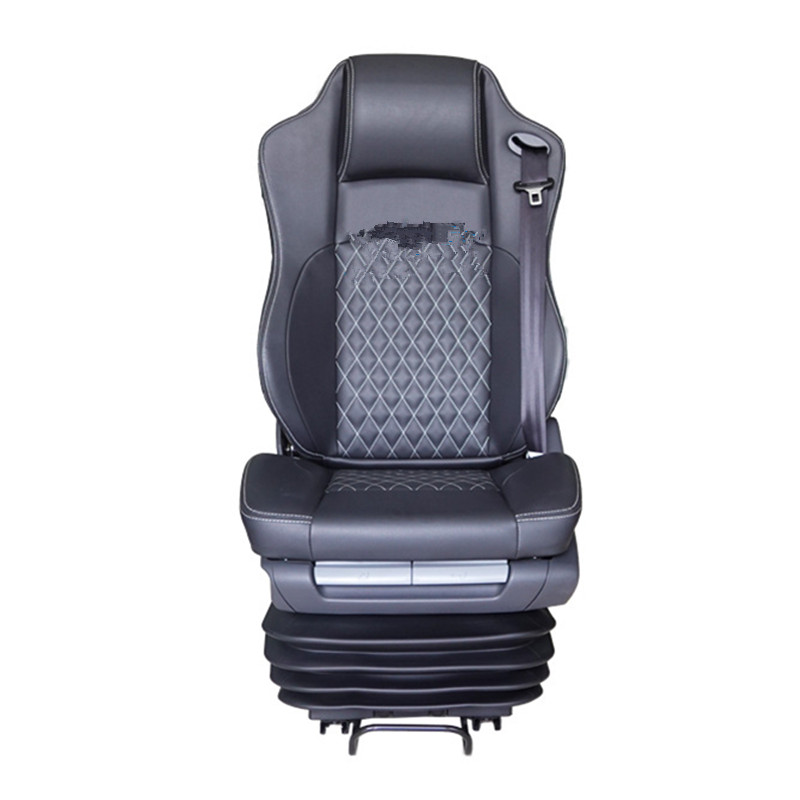How to Choose Bus Seats
How to Choose bus seats?
I. Core Considerations Before Selection
1. Clarify the Usage Scenario
- Long-distance Travel/Passenger Transport: Prioritize comfort, adjustability, and support. A 2+2 layout is recommended, with a seat pitch of ≥100cm.
- Short-distance Commuting/Public Transport: Focus on durability, easy cleaning, and passenger capacity. A 3+2 layout is commonly used.
- Business Reception: Pursue high-end texture and functional diversity. Optional independent seat layouts include 2+1 or 2+2.
2. Budget Planning
- Economy Grade: ¥300–800 per seat, suitable for public transport and regular passenger transport.
- Mid-to-High End: ¥800–2000 per seat, suitable for tour buses and business chartered vehicles.
- Luxury Grade: Over ¥2000 per seat, suitable for high-end customization and VIP reception.
II. Detailed Explanation of Core Selection Criteria
1. Safety: Non-Negotiable Priority
- Must comply with the GB 13057-2023 "Strength Requirements for bus seats and Their Vehicle Fastenings" standard and pass a 50km/h collision test.
- Seat Frame: High-strength steel accounts for ≥80% to ensure structural stability during collisions.
- Seat Belts: Standard 3-point seat belts with secure anchor points; the webbing must have a tensile strength of ≥14,700N.
- Seat Connection: Reliable connection between fasteners and the vehicle body structure, with anti-displacement design.
2. Comfort: Key to Enhancing Experience
- Ergonomic Design:
- Backrest Angle: 100°–110° to reduce back pressure.
- Seat Depth: 380–420mm to avoid pressure on the thighs.
- Seat Height: Ensure the knees are bent at approximately 90° with feet flat on the floor.
- Headrest: The top aligns with the top of the head, fits the neck curve, and provides cervical support.
- Cushioning System:
- High-density polyurethane foam (≥35kg/m³) with a rebound rate of >60% and anti-deformation performance.
- Dual-hardness design: Soft seat surface (support area hardness: 25–30°) and hard side edges (support area hardness: 40–45°) to enhance wrapping.
- Adjustment Functions (Essential for Long Distances):
- Multi-angle backrest adjustment (adjustment range ≥25°).
- 4-way adjustable headrest (height and angle).
- Up/down and forward/backward armrest adjustment.
- Some high-end seats are equipped with leg rests and lumbar support.
3. Material Selection: Balancing Practicality and Aesthetics
|
Material |
Advantages |
Disadvantages |
Applicable Scenarios |
|
Genuine Leather/Nappa Leather |
High-end texture, soft touch, enhances grade |
High price, requires regular maintenance, prone to aging |
Business reception, high-end travel |
|
PU Leather/Microfiber Leather |
Cost-effective, wear-resistant, easy to clean, waterproof |
Slightly poor breathability, stuffy in high temperatures |
Mainstream tour buses, passenger transport |
|
Fabric/Polyester Fiber |
Good breathability, high friction (anti-slip), affordable |
Easy to get dirty and hard to clean, slightly low durability |
City buses, school buses |
|
Leather-Fabric Mix |
Balances aesthetics and practicality, moderate cost |
Prone to wear at stitching joints |
Mid-to-high end passenger transport, commuting |
Tip: Prioritize breathable materials (fabric/perforated leather) in hot and humid southern regions; heating function materials are optional in northern regions.
4. Functional Configurations (Added Based on Needs)
- Basic Functions:
- Seat belts (mandatory standard configuration).
- Armrests (fixed/foldable).
- Cup holders (available in some vehicle models).
- Advanced Functions (Enhance Competitiveness):
- USB charging ports (essential for long distances).
- Small tables (for business/travel).
- Seat heating/ventilation (high-end configuration).
- Massage function (luxury buses).
5. Maintenance and Durability: Considerations for Long-Term Costs
- Easy-Clean Design:
- Waterproof and stain-resistant fabrics (e.g., PU leather, vinyl).
- Seamless structure for easy daily wiping.
- Durability Indicators:
- Fabric wear resistance test: ≥50,000 rubs without damage.
- Frame anti-rust treatment: Salt spray test ≥1000 hours.
- Service life under normal use: ≥5–8 years (up to 10 years for high-end seats).
III. Seat Selection Recommendations for Different Vehicle Types
1. Long-Distance Tour Buses
- Layout: 2+2, with 36–50 seats; ensure legroom ≥70cm.
- Core Configuration: High-rebound foam + adjustable headrest + multi-angle backrest + armrests + USB charging.
- Material: PU leather/microfiber leather (cost-effective) or genuine leather (high-end brands).
- Special Functions: Some models offer optional "airline-style seats" (can recline at a large angle, nearly flat).
2. Business Reception Vehicles
- Layout: Independent 2+1 or 2+2 layout; reduce middle seats to improve privacy.
- Core Configuration: Full genuine leather/Nappa leather + electric adjustment + leg rests + lumbar support + small tables.
- Features: Seat pitch ≥130cm to create a first-class experience; optional massage function.
3. City Buses/Commuter Vehicles
- Layout: Mainly 3+2 to maximize passenger capacity; seat pitch can be appropriately reduced (≥80cm).
- Core Configuration: Wear-resistant and easy-to-clean fabrics (e.g., vinyl), fixed armrests, and simple adjustment.
- Design Focus: Lightweight, easy to clean, sturdy structure, and adaptable to frequent starts and stops.
4. School Buses/Group Shuttle Buses
- Safety First: Comply with the GB 24406 school bus standard; seats have higher strength and strong impact resistance.
- Configuration: High backrests (to protect the head), 3-point seat belts, and moderate seat pitch.
- Material: Environmentally friendly and flame-retardant fabrics, scratch-resistant, wear-resistant, and easy to clean and disinfect.
IV. Brand and Price Reference (2025)
Mainstream Domestic Brands:
- Yutong: Leading market share; seats meet 50km/h collision standards, with high-strength steel frames (81.3%); price: ¥800–2000 per seat.
- King Long/Golden Dragon: Cost-effective with a rich product line; price: ¥600–1500 per seat.
- Adient/Johnson Controls: International brands with high-end quality; price: ¥1200–3000 per seat.
- BYD/Zhongtong: Seats matching new energy vehicles, lightweight design; price: ¥700–1800 per seat.
Quality Corresponding to Price Ranges:
- ¥300–600: Economy grade with basic functions; suitable for public transport and regular shuttles.
- ¥600–1200: Standard grade with ergonomic design and wear-resistant materials; suitable for mainstream tour buses.
- ¥1200–2500: High-end grade with full-function adjustment and high-quality materials; suitable for business and high-end travel.
- Over ¥2500: Custom luxury grade with airline-style experience and integrated multi-functions; suitable for top-tier business vehicles.
V. Practical Purchasing Steps
- Clarify the Demand List:
- Vehicle type, passenger capacity, and usage scenario.
- Budget ceiling, essential functions, and optional configurations.
- Local regulatory requirements (e.g., safety standards).
- On-Site Inspection and Comparison:
- Experience the comfort of different seats (sitting feel, support, and adjustment convenience).
- Check material texture and workmanship details (uniform stitching, edge treatment).
- Test the smoothness and stability of adjustment functions.
- Supplier Evaluation:
- Qualification certifications (ISO, 3C, GB certifications).
- After-sales service (warranty period, maintenance support).
- Production capacity (delivery cycle, customization capability).
- Sample Testing:
- Order 1–2 samples for testing before bulk procurement.
- Install and test for ≥1 month, and collect passenger feedback.
VI. Summary and Action Recommendations
Three Principles for bus seat Selection:
- Safety First: Must comply with national standards and pass collision tests.
- Comfort as the Foundation: Ergonomic design is key to long-distance travel experience.
- Practicality as the Priority: Materials and functional configurations should match the usage scenario, balancing initial investment and long-term maintenance costs.
Contact information:
Cangzhou Huayang Car Accessory Co.,Ltd.
WhatsApp/WeChat/Kakao talk/MB:+86 15030709203
Tel: +86 15030709203; +86 18733045230
QQ: 2761741790
Email: sales@hycaraccessory.com
ceo@hycaraccessory.com
sales@yiduspace.com
2761741790@qq.com
Website: www.hycaraccessory.com



